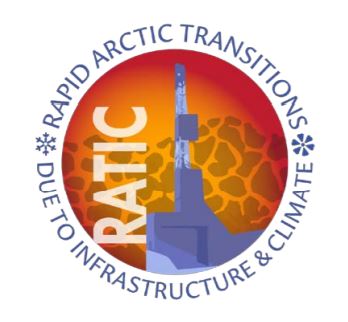 The Sustainable Arctic Infrastructure Forum (SAIF) was an IASC cross-cutting workshop involving principally the IASC Terrestrial, Social and Human, and Cryosphere working groups. The forum occurred 3 April, during Arctic Science Summit Week 2017, in Prague, Czech Republic. Eleven related scientific papers and six posters were presented during the Science Session 17.3 “Rapid Arctic Transitions due to Infrastructure and Climate (RATIC)”. SAIF is an activity of the IASC RATIC initiative. Thirty-nine individuals participated in the SAIF workshop. The program consisted of: (1) a series of introductory talks, (2) a keynote student presentation by Will Tyson, (3) breakout sessionsto address scientific and policy issues related to major types of infrastructure, and (4) discussion to address a journal publication and a RATIC strategy document. The major task of SAIF was to address the cumulative effects of four major types of infrastructure systems: indigenous infrastructure (e.g., camps, trails, corrals, migration corridors, etc.); onshore oil & gas fields (networks of roads, drilling and facility pads, pipelines, etc.); remote communities (village infrastructure); and urban infrastructure (cities). Plans for publication of the results from the forum are to summarize the results from the breakout groups, identify the science questions and policy issues that were common to all types of infrastructure and those that were unique to one or two types, and develop a strategy for addressing the questions and issues based on the tools, approaches and institutions identified by each breakout group. “Corridors” and “nodes” emerged as an organizing framework for developing research themes related to the various types of infrastructure. A “Prague Sustainable Infrastructure Scientific Research Agenda” identified the following tasks to be completed by RATIC in the next five years: (1) Promote the topic of “sustainable infrastructure development” as a key IASC research theme; (2) involve scientists, local communities, governments, industry and the general public in this research; (3) publish a synthesis of sustainable Arctic infrastructure research findings in peerreviewed scientific journals and more publicly accessible platforms; (4) pursue funding to continue the RATIC initiative; and (5) develop a strategic plan by December 2017.
The Sustainable Arctic Infrastructure Forum (SAIF) was an IASC cross-cutting workshop involving principally the IASC Terrestrial, Social and Human, and Cryosphere working groups. The forum occurred 3 April, during Arctic Science Summit Week 2017, in Prague, Czech Republic. Eleven related scientific papers and six posters were presented during the Science Session 17.3 “Rapid Arctic Transitions due to Infrastructure and Climate (RATIC)”. SAIF is an activity of the IASC RATIC initiative. Thirty-nine individuals participated in the SAIF workshop. The program consisted of: (1) a series of introductory talks, (2) a keynote student presentation by Will Tyson, (3) breakout sessionsto address scientific and policy issues related to major types of infrastructure, and (4) discussion to address a journal publication and a RATIC strategy document. The major task of SAIF was to address the cumulative effects of four major types of infrastructure systems: indigenous infrastructure (e.g., camps, trails, corrals, migration corridors, etc.); onshore oil & gas fields (networks of roads, drilling and facility pads, pipelines, etc.); remote communities (village infrastructure); and urban infrastructure (cities). Plans for publication of the results from the forum are to summarize the results from the breakout groups, identify the science questions and policy issues that were common to all types of infrastructure and those that were unique to one or two types, and develop a strategy for addressing the questions and issues based on the tools, approaches and institutions identified by each breakout group. “Corridors” and “nodes” emerged as an organizing framework for developing research themes related to the various types of infrastructure. A “Prague Sustainable Infrastructure Scientific Research Agenda” identified the following tasks to be completed by RATIC in the next five years: (1) Promote the topic of “sustainable infrastructure development” as a key IASC research theme; (2) involve scientists, local communities, governments, industry and the general public in this research; (3) publish a synthesis of sustainable Arctic infrastructure research findings in peerreviewed scientific journals and more publicly accessible platforms; (4) pursue funding to continue the RATIC initiative; and (5) develop a strategic plan by December 2017.
Read the full report here.

